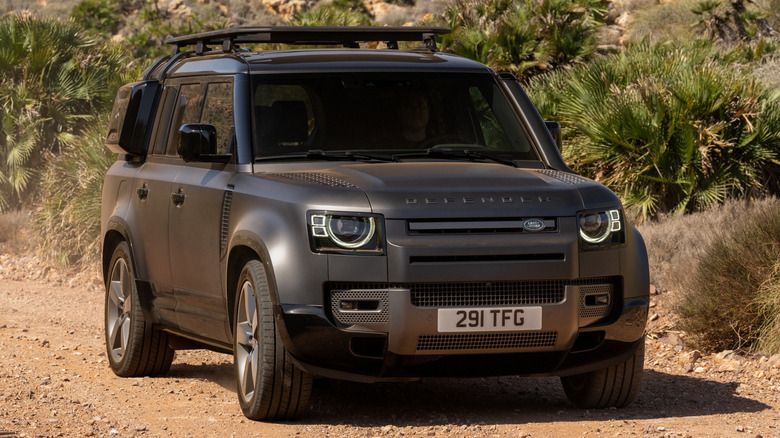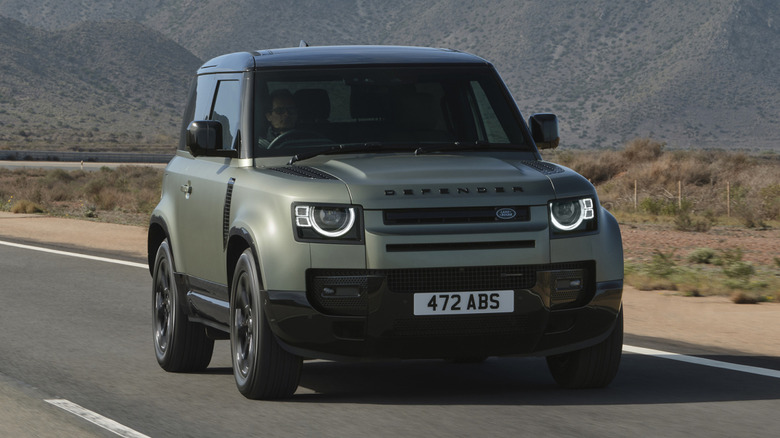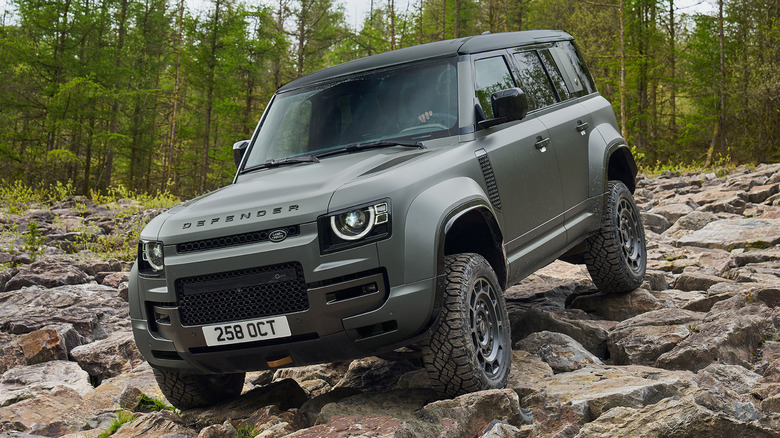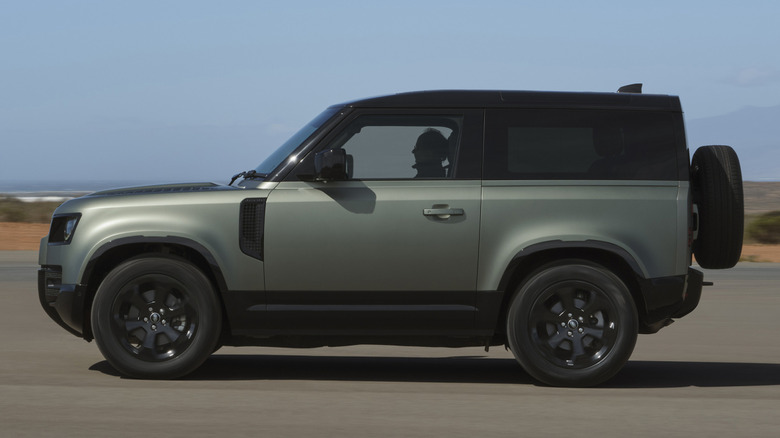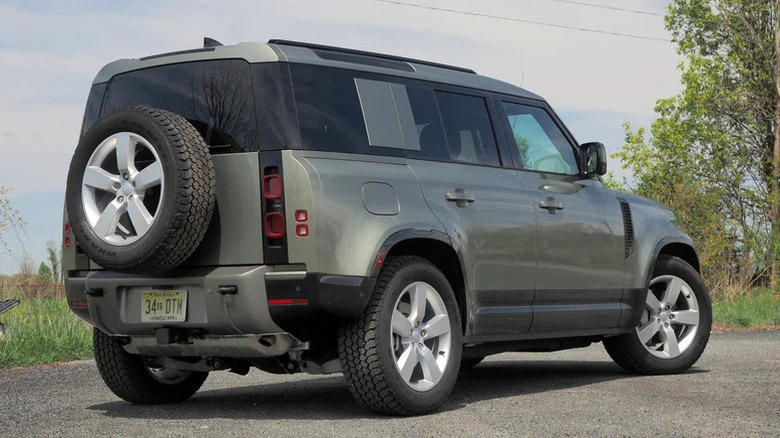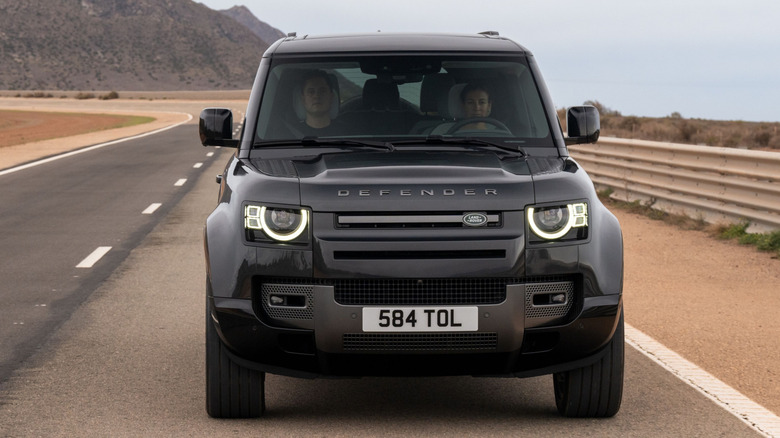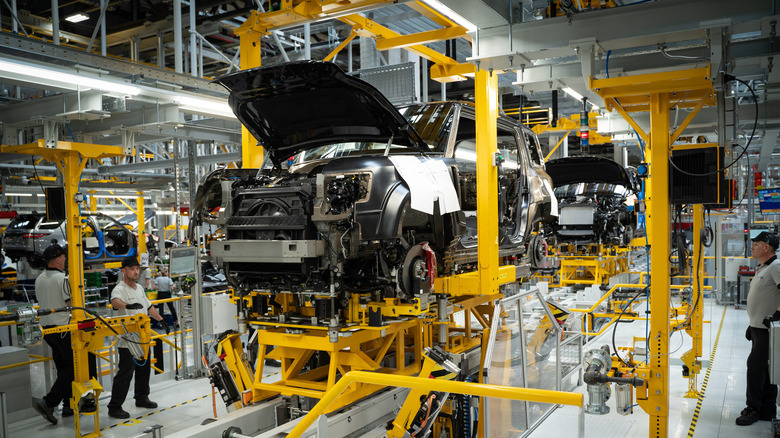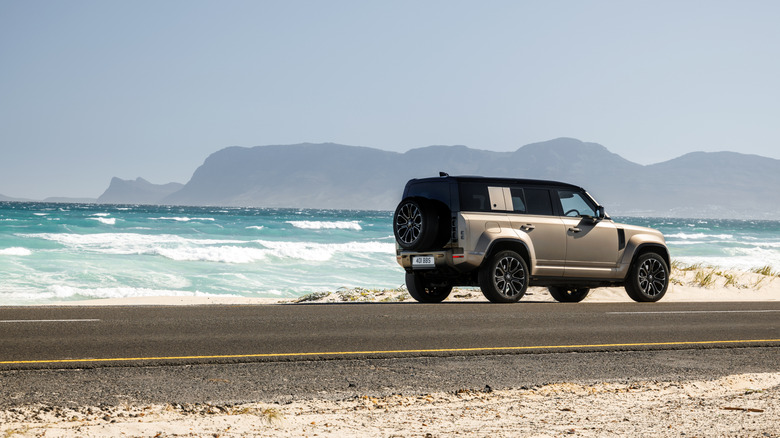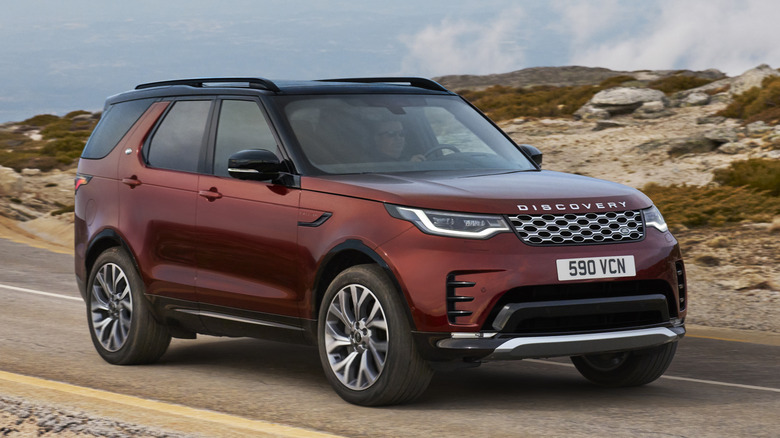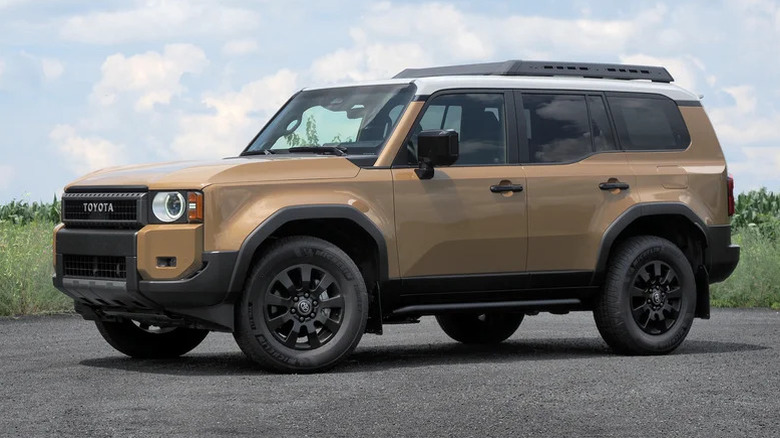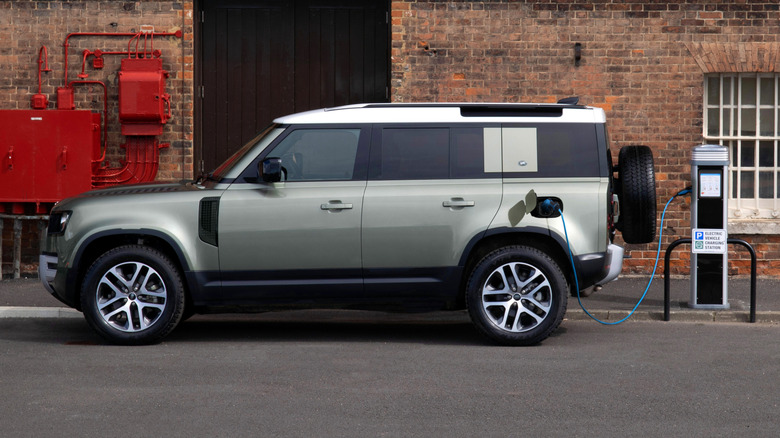13 Things You Should Know Before Buying A Land Rover Defender (New Or Used)
Ask most enthusiasts to name the most iconic off-road brands, and alongside its longtime rival Jeep, Land Rover will always crop up in the conversation. From its inception, Land Rover has churned out vehicles that excel on rough terrain, although many of its earlier vehicles were far from comfortable when drivers got back on the road. Recent models from the brand are a much more refined affair, with even the iconic Defender having been subject to a reinvention that saw it transformed from an old-school workhorse into an upscale luxury SUV.
Despite that transformation, it hasn't lost sight of its roots. It's still capable of conquering virtually any kind of terrain that a driver can throw at it, and that dual personality has made it popular among buyers looking for a highly versatile SUV. The Defender doesn't come cheap, either in new or used form, but its charms more than justify its premium pricing. Whether you're looking for a shiny new Defender or a used example that's already seen its fair share of muddy trails, we've rounded up 13 things you should know before you head to a dealership.
The Defender starts from around $60,000 for 2025
Buying a new Defender will cost more than buying many of its off-road focused contemporaries, as even the cheapest version starts just under $60,000 for 2025. In base-spec form, the cheapest Defender 90 starts from $58,750 (including a $1,850 destination and delivery fee), while the Defender 110 starts from $62,650. The largest Defender 130 variant will cost at least $71,550 once the destination and delivery fee is accounted for.
The base-spec S trim Defender 90 and Defender 110 are offered with 2.0L four-cylinder engines, while the base Defender 130 gets a 3.0L six-cylinder engine. That six-cylinder engine is also available on Defender 90 and Defender 110 variants from the X-Dynamic SE trim upwards. A 5.0L supercharged V8 engine is also available for all three variants, but it doesn't come cheap. The dedicated Defender V8 trim stretches into six-figure territory, but the Defender 110 also offers the option of fitting the V8 engine to the X-Dynamic SE trim for a starting price of $96,850.
Opting for the pricier engines also brings a significant increase in power. The base four-cylinder engine packs a modest 296 horsepower, while the six-cylinder bumps that figure up to 395 horsepower. The V8 engine is the most potent, with the Defender V8 trim offering 518 horsepower.
The range-topping Defender Octa launches for 2025
If the regular Defender V8 wasn't already powerful enough, Land Rover has launched a new special edition Octa trim for the 2025 model year. The headline upgrade is a twin-turbocharged, mild hybrid 4.4L V8 engine that offers 626 horsepower and 553 lb-ft of torque. That's enough to propel the Defender Octa from standstill to 60 mph in just 3.8 seconds, roughly on par with a Porsche Cayenne S. Except, unlike the Porsche, the Defender Octa is still extremely capable off-road.
Among a laundry list of changes are new, specially developed 33-inch Goodyear Advanced All‑Terrain Tires, which Land Rover says are the largest ever fitted to a production Defender. Additional underbody shields, a new off-road launch mode, and toughened front bodywork all help the Octa withstand the pressures of high-speed off-roading, but the luxurious interior and revised suspension ensure it remains comfortable to drive on the road too.
It has many talents, then, but the Defender Octa demands a steep premium compared to the regular Defender V8. It's only available as the Defender 110 and it starts from $153,850, around $40,000 more than a Defender 110 V8. The Defender Octa Edition One, which offers unique exterior and interior trim, costs even more, at a starting price of $169,650.
The Defender is available in 90, 110, and 130 variants
Most Defender devotees will already be aware of the differences between the 90, 110, and 130 variants, but for newer fans of the brand it's worth delving deeper into what the differences between the trio are. The Land Rover Defender 90 is the smallest and least practical of the bunch, with only two doors and the shortest wheelbase. Anyone wanting to get in and out of the rear row of seats will need to lower the front seats then twist themselves to get out of the door, something that we thought would quickly become grating if you had to do it regularly. While it loses marks on family-hauling practicality, it gains them in style, since the two-door Defender is the closest to the original Land Rover design.
In contrast, the Land Rover Defender 130 is the best practical choice if you have plenty of people and luggage to haul around on a regular basis. It sports an extended wheelbase and up to eight seats depending upon its configuration. It was also a later addition to the Defender lineup, joining the Defender 90 and Defender 110 in 2022 after the latter pair initially launched for the 2020 model year. It's a big SUV even by modern standards, and it's notably pricier than either the Defender 90 or Defender 110 too.
The Defender 110 is a good compromise
The Defender 130 is likely too large to be justifiable for most buyers, while the Defender 90's two-door configuration isn't the best if you've got kids in tow. The middle ground — and arguably the best compromise of the trio — is the Land Rover Defender 110, which offers five doors and two rows of generously sized seats. An optional third row can also be added, but it's a squeeze, so it's really only suitable for small children or occasional short journeys.
We were won over by the car's mix of upscale comfort and all-terrain chops, although our test route barely scratched the surface of its off-roading abilities. The biggest concern flagged during our review of the car was simply that the Defender's capabilities weren't going to be much use to the majority of buyers.
Plenty of cheaper or more refined SUVs boast the ability to handle the occasional gravel track or muddy trail, and so are more than capable of dealing with the demands of the average driver. It's unlikely that most Defender buyers will actually need one, although that doesn't stop plenty of people — ourselves at SlashGear included — from wanting one.
Fuel efficiency remains broadly the same between powertrains
No matter whether buyers opt for the base-spec four-cylinder engine or the range-topping V8, the Defender's fuel efficiency figures remain around the same. According to the EPA, both the 2.0L four-cylinder engine and the 3.0L V6 engine should achieve the same 19 mpg combined across most Defender trims, although some Defender 130 trims such as the Outbound drop that figure slightly to 18 mpg.
The Defender's V8 options are predictably less efficient than the four-cylinder and six-cylinder engines, but not by much. The Defender's supercharged 5.0L V8 sees an average combined figure of 16 mpg across the board. The twin-turbocharged 4.4L V8 engine in the Octa has not been rated by the EPA at the time of writing, but it's safe to assume it will be more thirsty than the standard V8 engine. The Defender certainly isn't a car you'll buy if you're looking to save fuel, although few proper off-roaders aside from the plug-in hybrid Jeep Wrangler 4xe can claim to be particularly efficient.
Despite its heritage, the Defender is not built in the U.K.
The original Defender was famously built at Land Rover's plant in the heart of the English Midlands, with Land Rover vehicles having been made at the Solihull assembly since the inception of the brand. However, when the original Defender was discontinued in 2016, the plant switched to making other Land Rover models. Today, it focuses on building high-margin models like the Range Rover and Range Rover Sport.
The success of the Range Rover sub-brand has kept the Solihull plant busy, and rather than build a new plant in the U.K. to accommodate the production of the revived Defender, JLR bosses decided to build the Defender in continental Europe. Today, it's built alongside the Discovery at a dedicated plant in Nitra, Slovakia, which opened in 2018.
Slovakia might not seem like the obvious choice for an international car brand to build a cutting-edge factory, but in fact it's home to plants owned by several other major carmakers including Volkswagen Group, Stellantis, and Kia. Carmaking accounts for a significant part of the country's overall industry, and the Land Rover plant there is responsible for producing Defenders for the entire global market. Being built in Slovakia means that Defenders are also potentially subject to incoming tariffs on EU-built cars, although the tariff situation continues to change rapidly as of this writing.
The Defender isn't as unreliable as some might think
Land Rover's reputation for making unreliable cars is well known, but the current generation Defender hasn't proved to be as unreliable as some car shoppers might assume it to be. It has received an "Average" reliability rating from JD Power every year since 2022, and logged complaints to the NHTSA remain low across all model years.
As a brand overall, Land Rover still fares quite poorly in dependability rankings by JD Power, lagging towards the back of the pack in its 2025 survey with significantly more complaints than average. However, Land Rover was still deemed to be more dependable overall than one of its long-standing competitors, Jeep.
In Consumer Reports' list of its least reliable cars, the outlet ranked three Jeep models in the list of the ten worst offenders, including the Wrangler. Models from Ford, Chevrolet, and GMC also made an appearance, but Land Rover's cars are notably absent from the list. That isn't to say that the Defender's reliability is flawless — there are plenty of smaller issues that owners have reported, many regarding software bugs — but on average, the Defender shouldn't be much less reliable than most other new SUVs.
The Defender does not retain its value well
The latest generation of the Defender offers a much more luxurious experience than the original, but it also now depreciates like a luxury vehicle. Depreciation forecasts from KBB show a high level of depreciation across the Defender range, with the Defender 90 estimated to retain only 37% of its value after its first five years on the road. The Defender 110 is forecast to retain only 35.8% of its value over the same time period, being the worst of the trio.
While the Defender 130 is the priciest variant to buy new, it's also forecast to hold a higher percentage of its value over time. According to KBB, buyers can expect the car to retain 40.4% of its sticker price after five years on the road. While none of those figures are particularly reassuring, they're also not unusual for the Defender's segment either. A significant number of luxury SUVs made our list of high-depreciation poor performers that owners might regret buying when it's time to sell, including the Jeep Grand Wagoneer, Range Rover, and even the smaller Range Rover Evoque.
Buying a classic Defender won't be cheap
Even though the latest Defender is forecast to depreciate significantly, buyers shouldn't expect a classic Defender to be subject to the same depreciation. In reality, the opposite is true. The original Defender is a sought-after vehicle, and buyers are willing to pay a significant premium to snag the best examples. The priciest examples on popular auction sites like Bring a Trailer are usually heavily modified and can sell for six-figure sums, and even cheaper examples often sell for as much as a new car. The exact amount varies, with the most affordable Defenders in running condition selling for around $25,000, and pristine cars usually selling for double that figure.
Part of the classic Defender's appeal comes down to its relative rarity. Although the name was first launched several years before, the model was only sold in the U.S. for a small portion of its life, between 1993 and 1997. It was then discontinued in the American market as it didn't meet changing safety regulations, but it remained on sale in other markets until 2016. Plenty of older examples can now be imported to the U.S. under the 25-year rule, but they still remain rare enough that prices continue to be high.
The Defender was originally launched to replace the Series III
Although the brand has made plenty of other models over its long history, the Defender remains the closest present-day successor to the original Land Rover of 1948. The brand's earliest cars are known as the Series I, with the Series II arriving in 1958. It brought with it a new, more powerful gas engine, but the basic design was carried over from the original. The Series III arrived in 1971 with a styling redesign and further tweaks, and a more significant overhaul was carried out in 1983. That year saw the launch of the Ninety and One-Ten, the first incarnations of what's now known as the Defender.
The key difference between the Ninety and One-Ten and older Land Rover models was the introduction of coil spring suspension, which helped the car to feel less agricultural to drive on the road. The Defender name wasn't officially launched until 1990, although the Ninety and One-Ten of 1983 are widely considered to fall under the same umbrella even if they didn't originally sport the Defender name. Between 1990 and 2016, the Defender received no major overhauls, although it did see a number of special editions released to commemorate the end of its production.
The Defender and Discovery are aimed at different audiences
Around the same time as the Defender name was first brought into use, Land Rover launched another model, the Discovery. From the start, the Discovery and Defender were designed to be different models that appealed to different types of buyers. While the Defender always remained the more hardcore, off-road focused option, the Discovery was intended to be a more family-oriented SUV. It had better on-road manners and was designed to be as comfortable for long road trips as it was dealing with muddy farm trails.
The modern Discovery continues to be pitched much the same way, and the Defender remains the better option of the pair for maximum all-terrain capability. However, the Defender's visual reinvention has also seen the Discovery emerge as a more under-the-radar option, without the same eye-catching design. The smaller Discovery Sport is also cheaper than the Defender, starting from $51,175 (including a $1,275 destination fee) but still with enough space for a family and their luggage.
The Defender has a significant number of rivals
As well as rivals within Land Rover's range, the Defender also had a significant number of rivals that hail from other brands. Toyota offers one of the most comprehensive ranges of all-terrain SUVs on the market, with the latest generation of the Land Cruiser being the closest rival to the Defender and the 4Runner also ending up similarly pricey in its top-spec trims. For a similarly upscale experience to a high-spec Defender, buyers could also consider the Lexus GX, which relaunched in 2024 as an upmarket version of the Land Cruiser.
Jeep also offers the Wrangler, which arrives for 2025 with top-spec trims that match the Defender's pricing. The Ford Bronco is also another highly appealing option if you're looking for retro charm, although it won't double up as a luxury vehicle in the same way as a Defender will. The Defender's field of competition looks set to expand in the coming years too, as the VW-backed Scout brand is aiming to launch an electric SUV that's similarly heritage-inspired later in the decade.
An all-electric Defender won't arrive anytime soon
Scout might be planning an all-electric off-road SUV, but Land Rover fans shouldn't expect an all-electric Defender to hit dealerships anytime soon. Talking to Autocar, Lennard Hoornik, JLR's chief commercial officer, said that although the brand has considered building an electric version of the current Defender, the limits of the platform mean that it hasn't managed to create a viable design so far. Hoornik said, "EV will need to come at quite a significant step in the evolution of the Defender." However, he wouldn't confirm to the outlet exactly when this significant step would be.
Whether that means a new generation of the Defender will eventually be launched with an all-electric option or that the Defender lineup will eventually incorporate a unique, separate electric platform alongside the current one remains unknown for now. However, it seems unlikely that the eventual EV Defender won't arrive in dealerships for years yet. A plug-in hybrid version of the Defender is also available in certain other markets, but at the time of writing, Land Rover has not announced plans to bring that model stateside either.
